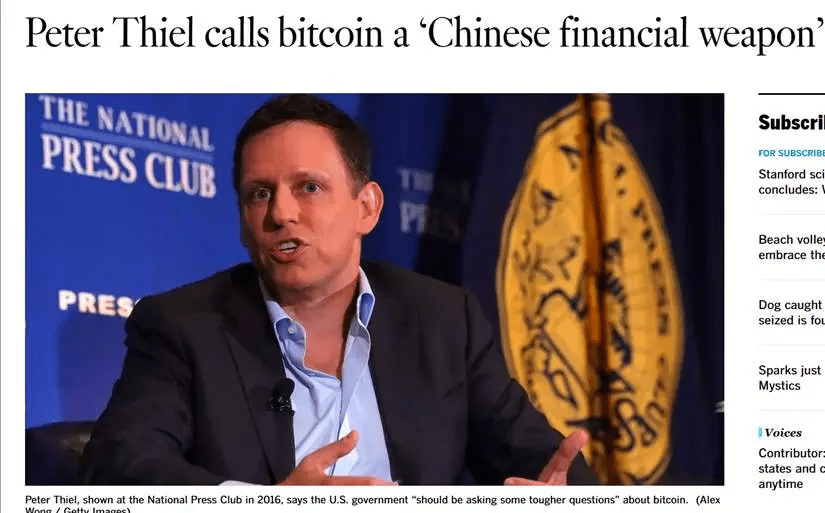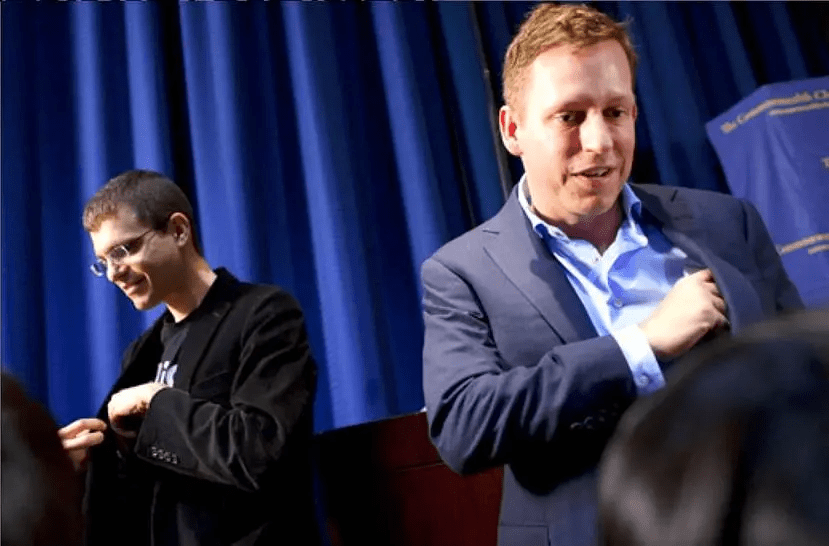Written by: Zz, ChainCatcher
In July 2025, a SEC filing ignited the crypto community: entities under Peter Thiel quietly acquired 9.1% of BitMine Immersion Technologies, becoming the largest investor in this Ethereum treasury. Upon the news, BitMine's stock price skyrocketed, reaching a peak of 29.3% during trading.
The X platform exploded: the PayPal mafia godfather finally took action on Ethereum, has Peter Thiel shifted from Bitcoin to? Is he trying to replicate MicroStrategy's playbook?
The market is so agitated, it is not without reason. Just a year ago, Peter Thiel was publicly questioning Bitcoin: We already have ETFs, I do not know who else will come to buy. When institutional forces have already entered the scene, who can drive the next wave? From Bitcoin to heavily investing in Ethereum, what game is this Silicon Valley billionaire playing?
The ambition behind holding $1 billion worth of ETH
BitMine's ambition is unpretentious: to become the Ethereum version of MicroStrategy. On July 14, 2025, BitMine held Ethereum worth $500 million (163,142 ETH). Three days later, this number doubled to $1 billion, 300,657 ETH. Even in the crypto world, this accumulation speed is astonishing.
But what Peter Thiel is focusing on is far more than just another corporate treasury. In 2023, a move by Founders Fund revealed his investment landscape: investing $200 million to buy Bitcoin and Ethereum, each accounting for half. This configuration itself is a signal that Ethereum has already equaled Bitcoin.
In addition to the heavy blow of BitMine, Peter Thiel's layout in the Ethereum ecosystem has already quietly begun:
Trading infrastructure: invested in Bullish Exchange in 2021, Peter Thiel serves as a senior advisor.
Compliance infrastructure: invested in Paxos in 2024 (a regulated stablecoin issuer), and continued to increase investment in 2025, participating in Ubyx, aiming to become the Visa of the stablecoin field.
DeFi infrastructure: lead investment in Avantis in June 2025, focusing on on-chain derivatives.
Layer-2 scaling: invested in Caldera. When mainnet gas fees remain high, Layer-2 is key to making DeFi truly usable.
Bitcoin is digital gold, while Ethereum is the new financial market. An investor close to Founders Fund revealed that for store of value, buying Bitcoin is sufficient. But to control the future financial infrastructure, you need Ethereum.
This judgment is based on evidence. When Bitcoin was still entangled in store of value vs payment, Ethereum had already become: the main battlefield of DeFi (with locked value exceeding $100 billion), the preferred platform for stablecoins (USDT, USDC mainly circulate on Ethereum), and the foundational layer for the tokenization of Real World Assets (RWA).
More critically, Ethereum can generate interest. This is something Bitcoin cannot do. BitMine's Ethereum treasury strategy precisely targets this, allowing assets to generate cash flow.
Peter Thiel's ambitions go beyond this: Bullish Exchange secretly submitted an IPO (June 2025), supported the creation of Erebor Bank, which specializes in serving crypto enterprises (planning to hold stablecoins), and controls industry discourse through CoinDesk. The picture is clear: he is no longer satisfied with holding assets, but wants to control the pipeline of asset flows.
The proportion of Ethereum ecosystem in Founders Fund's blockchain investment portfolio has also been gradually rising. If 2014-2022 was Peter Thiel's Bitcoin era, focusing on value storage and ideological narrative, then after 2023, he officially enters the Ethereum era, building practically usable financial infrastructure.
Bitcoin has won the ideological war, but Ethereum will win practical applications. When central bank digital currencies, corporate stablecoins, and tokenized securities become a reality, they will all run on Ethereum.
Peter Thiel holds BitMine shares through various entities, not just investing but preparing for control. If BitMine becomes the largest corporate Ethereum holder, Peter Thiel will effectively become the shadow central bank of the Ethereum ecosystem. From PayPal to Bitcoin, and then to Ethereum, Peter Thiel’s dream of a financial empire has never changed; only the tools are continuously evolving.
The leading Founders Fund began accumulating when Bitcoin was at $1,000.
When Bitcoin was still hovering around $1,000, Founders Fund had already begun accumulating. According to insiders, the first batch of investment reached tens of millions of dollars, which was considered aggressive among institutional investors at the time.
But Peter Thiel's ambitions do not stop there. In 2013, he invested in Block.one (which later developed EOS). Although EOS ultimately failed to shake Ethereum, this investment revealed his true intentions: what he wanted was not Bitcoin itself, but the next Bitcoin.
What is even more intriguing is his layout path:
Mining side: investing in BitMine in 2025 is just the latest move. He participated in Layer1 funding as early as 2018.
Trading side: before Bullish, he was an early investor in Kraken. Compared to Coinbase's compliance route, Kraken maintains a more cypherpunk style, which is very Peter Thiel.
Infrastructure: In 2021, when everyone was chasing DeFi tokens, Founders Fund quietly invested in Voltage to provide infrastructure for the Bitcoin Lightning Network.
Peter Thiel's understanding of Bitcoin goes far beyond simply digital gold. In April 2021, during a conversation with former Secretary of State Pompeo, he threw out the idea: Bitcoin could be a financial weapon used by China to undermine the dollar.

The crypto community is in an uproar. Supporters call him a traitor, while opponents label him a conspiracy theorist. However, placing this statement within Peter Thiel's overall ideological framework, the logic becomes clear: Bitcoin is not just an investment, but a geopolitical tool. It can seize the initiative in the new financial war.
Interestingly, just a year later, he changed his tune at the Bitcoin conference, describing it as a revolutionary weapon against the financial gerontocracy. He even listed his enemies: Buffett, Larry Fink of BlackRock, and Jamie Dimon of JPMorgan.
Facing conservatives, he talks about national security. Facing the crypto community, he talks about the revolution of freedom. What remains unchanged is the core goal: to promote a new order independent of the traditional financial system. This precisely showcases Peter Thiel's core trait: using narrative as a weapon.
The results are significant: timely exit before the crypto winter in 2022, making a profit of $1.8 billion; in 2023, when Bitcoin dropped to $30,000, he again took action, buying $100 million. A textbook example of high selling and low buying.
A noteworthy detail: in July 2024, when the Bitcoin ETF was launched and institutional funds flooded in, Peter Thiel publicly stated that he was uncertain about a significant increase from here. The real weapon is never an ETF that everyone can buy.
The ambition behind all the layouts is an unfinished currency dream.
Looking at the Founders Fund's investment portfolio, the pattern is clear: almost no investment in DApps, little interest in GameFi, and a shallow approach to NFTs. What he is really interested in are: Layer2 scaling solutions (Caldera), compliance infrastructure (Paxos), derivatives protocols (Avantis), stablecoin networks (Ubyx). Protocols are superior to products; this is Peter Thiel's creed.
Let's go back to 1998 when 23-year-old Peter Thiel and Max Levchin founded PayPal. What was their initial vision? Not to create a payment tool but to create a new form of currency.

As early as ten years before Bitcoin's birth, Peter Thiel was thinking about how to disrupt the monetary system. PayPal even developed a PalmPilot application that could transmit digital cash via infrared. Ultimately, due to regulatory pressure, they had to transform into a traditional payment company.
In 2002, eBay acquired PayPal for $1.5 billion. The first thing Peter Thiel did after cashing out: founded Clarium Capital, systematically searching for the next currency revolution opportunity. He waited for 12 years.
In 2014, when Peter Thiel first seriously studied Bitcoin, what he saw was not electronic cash, but the unfinished dream of PayPal. We live in a world where Bitcoin is unregulated and atoms are regulated. This is how Peter Thiel summarized it in 2015. The implication is: in the digital world, you can build anything, including a brand new financial system.
In (From Zero to One), Peter Thiel repeatedly emphasizes: competition is the game of losers; monopoly brings excess profits. The experience of PayPal taught him that establishing a financial monopoly in the traditional world is nearly impossible. Regulation will stifle you, and big banks will besiege you. Cryptocurrency changed the rules of the game.
How to establish a monopoly in a decentralized world? The answer is: control the underlying infrastructure. When everyone is building on Ethereum, owning Ethereum is equivalent to collecting rent. When all transactions require stablecoins, controlling the stablecoin protocol is equivalent to printing money. When regulation finally arrives, owning a compliance license is equivalent to holding a ticket to enter.
Peter Thiel even funded key figures in this revolution. In 2014, his Peter Thiel Fellowship gave 19-year-old Vitalik Buterin $100,000, leading him to drop out of the University of Waterloo and develop Ethereum full-time. In a sense, Peter Thiel not only invested in the infrastructure but also in the people building the infrastructure.
This explains why Peter Thiel is simultaneously laying out Erebor Bank (traditional license) and DeFi protocols (decentralized finance). Regardless of which path he takes in the future, he is a winner. A deeper reason may be that in his view, cryptocurrency is not PayPal 2.0, but what PayPal was supposed to become: a truly free global financial system, not controlled by any government.
Now, Peter Thiel's crypto empire has taken shape.
In 2025, Peter Thiel is no longer satisfied with being a passive holder of coins. Through BitMine, Bullish, and Erebor, he is building a complete crypto financial empire.
As I write this, a question arises: Why is Peter Thiel so aggressive while traditional financial giants are still observing? Perhaps the answer lies in his 2015 statement: We live in a world where Bitcoin is unregulated and atoms are regulated.
For Peter Thiel, cryptocurrency is not only a financial revolution but also the ultimate tool for building an unregulated Bitcoin world. Now is the time to place bets.
After all, as his friend, Tesla CEO Elon Musk, said: the best adventures are calculated risks. In the ultimate adventure of cryptocurrency, Peter Thiel's calculations have only just begun.


